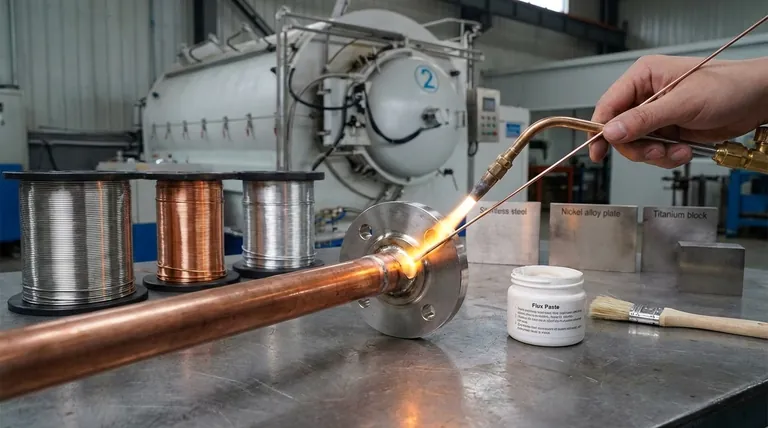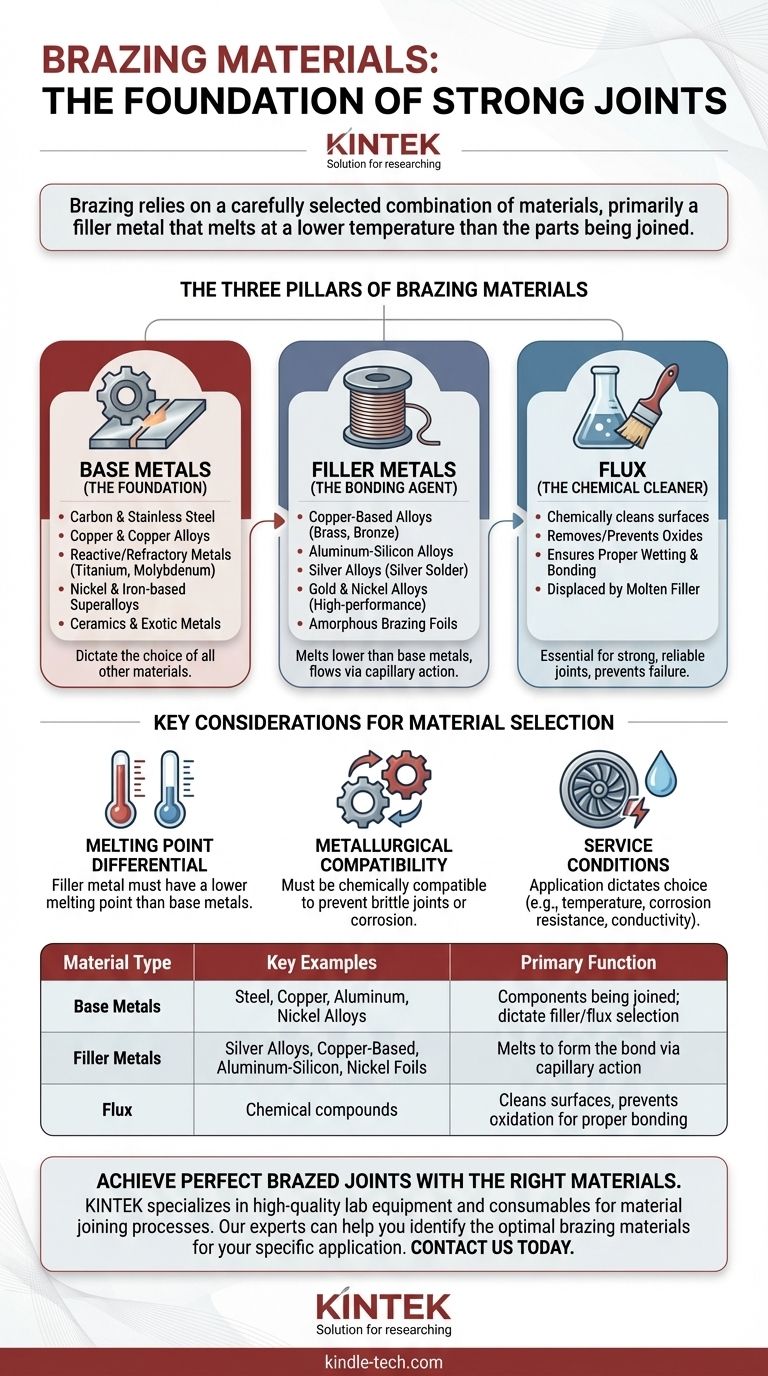ろう付けは、慎重に選ばれた材料の組み合わせに依存します。主に、接合される部品よりも低い温度で溶融するフィラーメタルです。一般的なフィラーメタルには、アルミニウム-ケイ素合金、銅ベースの合金(真鍮や青銅など)、銀合金、ニッケルベースのアモルファス箔が含まれます。これらは接合される母材、そして多くの場合、表面を清浄にして強力な接合を確実にする化学的なフラックスと連携して機能します。
ろう付けの基本原理は、接合される母材、融点が低いフィラーメタル、および接合のために表面を準備するフラックスという、3つの異なる材料間の相互作用です。プロセス全体の成功は、これら3つのコンポーネントの正しい選択と適合性にかかっています。

ろう付け材料の3つの柱
ろう付けに使用される材料を完全に理解するには、フィラーワイヤーだけでなく、それ以上のものを見る必要があります。このプロセスは、部品自体、接合剤、および清浄剤を含むシステムです。
母材:基盤
母材は、接合しようとしている部品です。他のすべてのろう付け材料の選択は、これらの金属の特性によって決まります。
ろう付けは非常に用途が広く、一般的な鋼から航空宇宙や防衛などの要求の厳しい産業で使用される高度に専門化された合金まで、幅広い材料の接合に使用できます。
ろう付けで頻繁に接合される母材の例は次のとおりです。
- 炭素鋼、鋳鉄、ステンレス鋼
- 銅および銅合金
- チタン、ジルコニウム、モリブデンなどの反応性金属および耐火性金属
- ニッケルおよび鉄ベースの超合金
- ベリリウムなどのセラミックスおよびエキゾチックメタル
フィラーメタル:接合剤
フィラーメタルはろう付けプロセスの核となります。これは、母材よりも低い温度で溶融するように設計されており、毛細管現象によって接合部に引き込まれ、固化して接合部を形成します。
フィラーメタルの組成は、最終的な接合部の強度、導電性、耐食性を決定します。
一般的なフィラーメタルの系統:
- 銅ベースの合金: 鋼、鋳鉄、銅合金の接合に広く使用されます。真鍮(銅-亜鉛)や青銅(銅-スズ)を含むこれらのフィラーは、優れた熱伝導性と電気伝導性を提供します。
- アルミニウム-ケイ素合金: 自動車およびHVAC用途で一般的なアルミニウム部品のろう付けの標準的な選択肢です。
- 銀合金: 「銀ろう」と呼ばれることが多く、これらのフィラーは高い強度と延性を持ち、さまざまな金属の接合に使用されます。
- 金およびニッケル合金: 航空宇宙や医療機器など、極端な耐食性、高温強度、または特定の冶金適合性が要求される高性能用途に使用されます。
- アモルファスろう付け箔: ニッケル、鉄、ホウ素、ケイ素などの元素で作られた最新の材料です。これらの箔は、正確で均一な接合部を提供し、先進的なエンジニアリング分野で一般的です。
フラックス:化学的洗浄剤
フラックスは、多くのろう付け作業における縁の下の力持ちです。その役割は、加熱中に表面酸化物を除去し、その形成を防ぐことによって、母材とフィラーメタルを化学的に清浄にすることです。
フラックスがないと、これらの酸化物がフィラーメタルが母材を濡らし、接合するのを妨げ、弱く、または失敗した接合部につながります。フラックスはフィラーメタルよりも先に溶融し、表面を準備した後、溶融したフィラーが接合部に流れ込む際に押し出されます。
材料選択のための重要な考慮事項
材料の適切な組み合わせを選択することは恣意的ではなく、冶金学と最終部品の意図された用途に基づいた技術的な決定です。
融点差
ろう付けの最も基本的なルールは、フィラーメタルの融点が母材の融点よりも低いことです。これにより、接合される部品がプロセス中に溶融したり変形したりしないことが保証されます。
冶金学的適合性
フィラーメタルは、母材と化学的および冶金学的に適合している必要があります。適合しない組み合わせは、脆い接合部、腐食、またはその他の形態の早期の故障につながる可能性があります。
サービス条件
最終的な用途が材料の選択を決定します。トラクター用の油圧継手には、ジェットエンジンのタービンブレードとは異なる特性が必要です。動作温度、腐食性要素への露出、必要な電気伝導性などの要因が、フィラーメタルの選択を導く必要があります。
用途に応じた材料の選択
材料の選択は、接合する母材と最終アセンブリの性能要件によって決定されるべきです。
- 鋼または銅の一般的な製作が主な焦点の場合: 銅ベースのフィラーは、優れた強度と導電性を持つ費用対効果が高く信頼性の高いソリューションを提供します。
- アルミニウム部品の接合が主な焦点の場合: 適切なフラックスと組み合わせたアルミニウム-ケイ素フィラーメタルが、標準的かつ正しい選択です。
- 高性能または特殊な用途が主な焦点の場合: ニッケル、銀、または金ベースの合金は、航空宇宙、防衛、または医療部品に要求される優れた強度、耐熱性、耐食性を提供します。
母材、フィラーメタル、フラックスのそれぞれの役割を理解することが、強力で信頼性の高いろう付け接合部を作成するための鍵となります。
要約表:
| 材料の種類 | 主な例 | 主な機能 |
|---|---|---|
| 母材 | 鋼、銅、アルミニウム、ニッケル合金 | 接合される部品。フィラー/フラックスの選択を決定する |
| フィラーメタル | 銀合金、銅ベース、アルミニウム-ケイ素、ニッケル箔 | 毛細管現象により溶融して接合部を形成する |
| フラックス | 化学化合物(さまざまな製剤) | 表面を清浄にし、適切な接合のために酸化を防ぐ |
適切な材料で完璧なろう付け接合部を実現しましょう。母材、フィラー合金、フラックスの正しい組み合わせを選択することは、接合部の強度と性能にとって極めて重要です。KINTEKは、材料接合プロセス用の高品質なラボ機器と消耗品を専門としています。当社の専門家は、一般的な鋼材を扱っている場合でも高度な合金を扱っている場合でも、お客様の特定の用途に最適なろう付け材料を特定するお手伝いをいたします。今すぐお問い合わせいただき、プロジェクトのニーズについてご相談の上、信頼性の高い高強度の接合を確保してください。#ContactForm
ビジュアルガイド




















